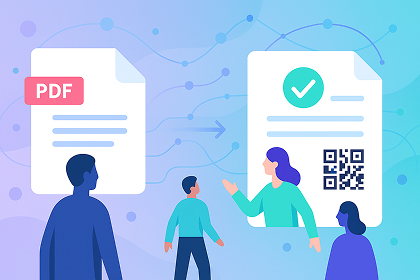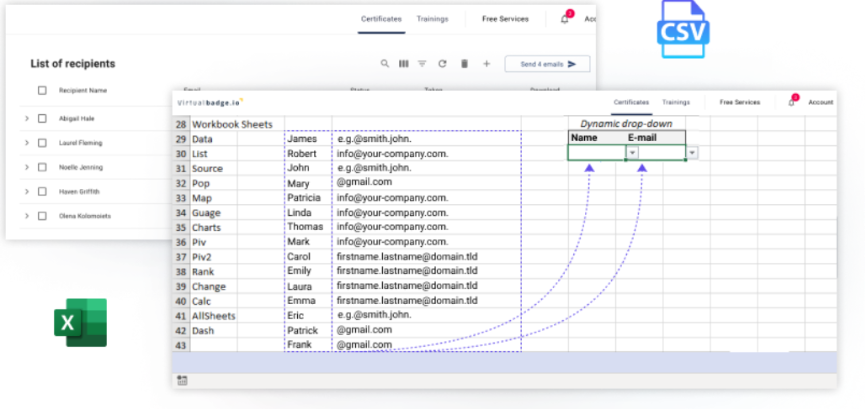No user accounts required for your recipients -
Existing certificates and badges always stay valid


How verifiable digital credentials are replacing traditional PDF certificates and setting new standards



Educational providers, universities, and training organizations are now transitioning toward verifiable digital credentials: A more secure, efficient, and interactive way to recognize learning achievements.
This shift is not just a matter of convenience; it reflects a fundamental change in how education is validated. As the digital transformation of the learning sector accelerates, organizations are realizing that their certification process must evolve as well.
Key drivers behind this transformation include:
The result is a new standard for digital recognition: certificates that are verifiable, tamper-proof, and connected to their issuer. This evolution enhances both trust and efficiency. setting the foundation for the future of credentialing.
PDF certificates once fulfilled a simple purpose: provide participants with proof of completion. However, their technical nature makes them inherently limited in a modern, data-driven learning environment.
Common characteristics of traditional PDF certification:
These steps are straightforward, but they reveal key flaws that become critical as organizations scale.
Main challenges of static PDFs:
These weaknesses create reputational and operational risks for educational institutions. A manipulated PDF can easily undermine the credibility of an entire training program.
According to the article Digital Badges Build Trust: Verifiable Credentials Explained, the inability to verify PDF certificates online contributes to a growing trust gap between learners, employers, and course providers.
The need for secure and verifiable digital credentials is therefore not optional but essential. They enable instant validation and protect both the issuer’s reputation and the learner’s achievement; a crucial advancement for modern education.
The transition from static PDFs to verifiable digital credentials represents a fundamental shift in how educational achievements are issued, verified, and shared. Instead of existing as isolated files, modern credentials are part of an interconnected digital ecosystem where authenticity can be confirmed instantly.
What are verifiable digital credentials?
Verifiable credentials combine a visual certificate or badge with secure metadata that proves its authenticity. Each credential includes a unique validation link or QR code that leads to a verification page hosted by the issuer or a trusted platform.
This verification page confirms:
This approach creates a direct connection between the credential and its source, ensuring complete transparency and eliminating the possibility of manipulation.
While both serve to recognize achievements, they have different purposes:
By combining both, educational providers can represent learning outcomes in a modern and flexible way that aligns with today’s professional landscape.
Verifiable credentials rely on secure web-based validation and standardized metadata formats such as the Open Badges Standard. This ensures interoperability across systems and long-term accessibility for learners.
As described in the article How to Use Digital Certificates for Professional Training, verifiable certificates not only increase authenticity but also simplify administrative processes and strengthen participant engagement.
By replacing static files with data-driven, verifiable links, educational institutions move closer to a more trustworthy and scalable digital ecosystem.
The adoption of verifiable digital credentials is not only about security. It is also a powerful operational and marketing advantage for organizations that issue certificates regularly.
Key benefits include:
1. Efficiency and automation
2. Security and credibility
3. Brand visibility and engagement

4. Data and analytics
5. Seamless integrations
As demonstrated in the article How to Automate Certificate Issuance with Virtualbadge.io, automation and verification go hand in hand. Once a course or event is completed, every participant automatically receives a secure, verifiable certificate, saving time and ensuring professionalism at every step.
By implementing verifiable digital credentials, educational providers can transform their certification process from a manual administrative task into a strategic asset that enhances trust, efficiency, and visibility.
Step-by-step implementation guide:
1. Design your branded template
2. Integrate participant data

3. Generate and send credentials automatically
4. Enable instant verification
5. Encourage sharing on professional networks
As outlined in the article How to Create Open Badges for Free, implementing a verifiable credential system does not require complex technical setup. The key is to use an intuitive platform that provides both automation and control, ensuring a consistent, trusted certification experience.
The transition from static PDF certificates to verifiable digital credentials is transforming how educational achievements are recognized and trusted. By implementing verifiable digital credentials, organizations gain more than just efficiency; they create lasting value for learners, employers, and their own brand.
Key takeaways:
Modern credentialing is no longer about sending PDF files; it is about building transparency, trust, and connection between institutions and learners.
Schedule a free demo with Virtualbadge.io to see how easily your organization can design, issue, and verify digital certificates that truly stand out.
* You can find the organisation ID in the URL when you access your LinkedIn Company page as an admin.


Marketing
Nov 14, 2025
6 min
Use Virtualbadge.io to design and send digital certificates that create trust - in less than 10 minutes.